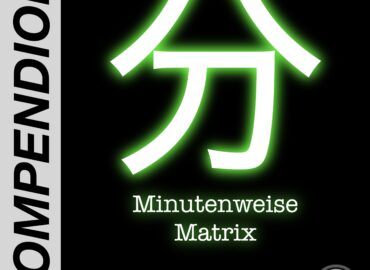A Puzzle Piece for the Trans* History – Dora Richter’s Baptism Record Found
The destruction of the Berlin Institute for Sexology in 1933 will have its 90th anniversary in the next few days. This text is intended to be a small puzzle piece in memory of it.
The text is about the exact birth date of Dora Richter, a pioneer of trans* history in Germany of the 20s and 30s of the last 20th century.
Comments in advance
- This text is not finished, it will be further updated as there are new findings and corrections.
- In the text, Dora’s name assigned at birth is mentioned, which cannot be avoided when working with genealogical sources.
- In the text, the German names of places are used, as the region was German-speaking at that time. The Czech place names are additionally indicated at the first mention of the places.
Who was Dora (Dorchen) Richter?
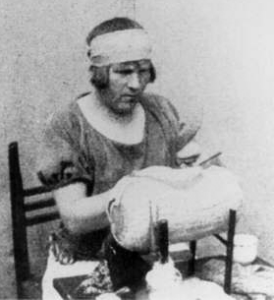
Lili Elbe is now quite well known as one of the first known trans women to undergo a series of gender confirmation surgeries in 1930/1931. Much less is known about three trans contemporaries of hers who underwent surgery a bit earlier: Dora Richter, Charlotte Charlaque and Toni Ebel. All three were employed at the Institute for Sexology, which was destroyed in 1933, and whose holdings were plundered, stolen and burned and are now only fragmentarily preserved. The same thing happened to the people who worked there – traces of her whereabouts are lost, or scattered to the winds.
Thanks to the work of the Magnus Hirschfeld Society, we know a lot again today, including about the three trans women mentioned.
- Raimund Wolfert published a book in 2021 about the actress and dancer Charlotte Charlaque (1892–1963), who emigrated to the USA, in which he traces her life and her environment as well as possible (Wolfert 2021).
- Again Raimund Wolfert, together with Ezra Paul Afken, curated an exhibition on the painter Toni Ebel (1881–1961), who also survived the Nazi era in exile and lived in the GDR after 1945 until her death (Website).
- The third trans employee of the institute known by name was Dora (called "Dorchen") Richter, she was the first trans woman to undergo gender confirmation surgery (in the modern sense), the first procedure was performed as early as 1922, followed by others in 1931 (Abraham 1931, p. 224). She is also mentioned in recent trans historical literature (e.g. Wolfert 2021 and Herrn 2022). But both about her birth and her whereabouts after 1933 – 90 years later – we still know very little!
Different statements about their origin
Until now, no exact dates of birth of Dora Richter were known, and there were different statements in different sources. The oldest and probably most reliable source is Werner Holz’s dissertation from 1924, which contains a detailed discussion of Dora’s case (Holz 1924, p. 4ff., see also Herrn 2022, p. 184ff.). There, April 16, 1892 was given as her birthday, but only the "Bohemian Ore Mountains" were given as the origin, and that her father had been a musician.
In a medical journal from 1933, on the other hand, a Saxon village is mentioned (Geburtenregelung 1933, p. 83). Furthermore, the year 1891 for the birth haunts the Internet (also in the Wikipedia), and Karlovy Vary is sometimes given as the place of birth. The latter probably goes back to a statement by Charlotte Charlaque from the 50s, when she mentions Karlovy Vary as Dora Richter’s hometown (Wolfert 2021, p. 76, his source is Curtius 1955, p. 27). Meyerowitz deviates even further in her book "How Sex Changed", she states 1882 and writes that Dora was born into a poor peasant family in eastern Germany (Meyerowitz 2004, p. 19, her source probably is Najac 1931, p. 183).
In the end, there were no exact statements, and the more often the articles quote each other, the less precise the details became.
Search
There were no civil records in Bohemia around 1892, so the church records are probably the best source of research. Searches on Ancestry and FamilySearch were initially unsuccessful. What about the regional church records?
About researching church records
A search in church records can be quite tedious if the exact location is not known. The physical baptism, marriage and death registers are/were scattered over countless small and smallest congregations and often inaccessible. In addition, the formerly German-speaking areas in Bohemia have been completely changed by fleeing and resettlement or are now depopulated.
If the books have been filmed and/or digitized on microfiche, they are also difficult to index as handwritten sources. And for the human eye, the manuscripts are sometimes not easy to decipher, many priests did not have a particularly legible writing.
After all, there is usually a name index, so it is not necessary to go through the entries one by one.
Thanks to a Bavarian-Czech cooperation project, the church records for the West Bohemian area have been digitized (Porta fontium archive project). This makes it much easier to search the area without having to travel on site and evaluate church records manually (which is undoubtedly appealing, but quite time-consuming).
Clues for the search
Based mainly on the statements from Holz’s dissertations and a few other sources, the following clues for the search could be determined:
- Birth name: Rudolf or Rudolph Richter
- Birthday: April 16, 1892, possibly also 1891
- Place of birth: a village in the mountains, presumably in the Bohemian Ore Mountains, i.e. the narrow strip of the Ore Mountains on the Czech side, possibly also in Karlovy Vary or the region there – although Karlovy Vary itself is not in the Ore Mountains anymore
- Religion: Catholic (which makes Bohemia much more likely than Saxony)
- Father’s profession: musician (which does not help with the direct search, but with the plausibility check of a possible baptismal entry)
Parish register entry found!
The research in the church registers in the mountainous regions north of Karlovy Vary actually led to success after some time!
On April 16, 1892 in the small village of Seifen (today Ryžovna, in the ridges of the Ore Mountains on the Bohemian side at an altitude of about 1,000 m) a Rudolf Richter was born and baptized Catholic on April 17, and the father was a musician. Later, a note about the change of the first name was added and the name in the baptismal entry was corrected (link)! In addition, the parish register contains a letter about the permission to change the name including the instruction to correct the name (Link).

Below are transcriptions and transcriptions of the entries.
Entry in the parish register
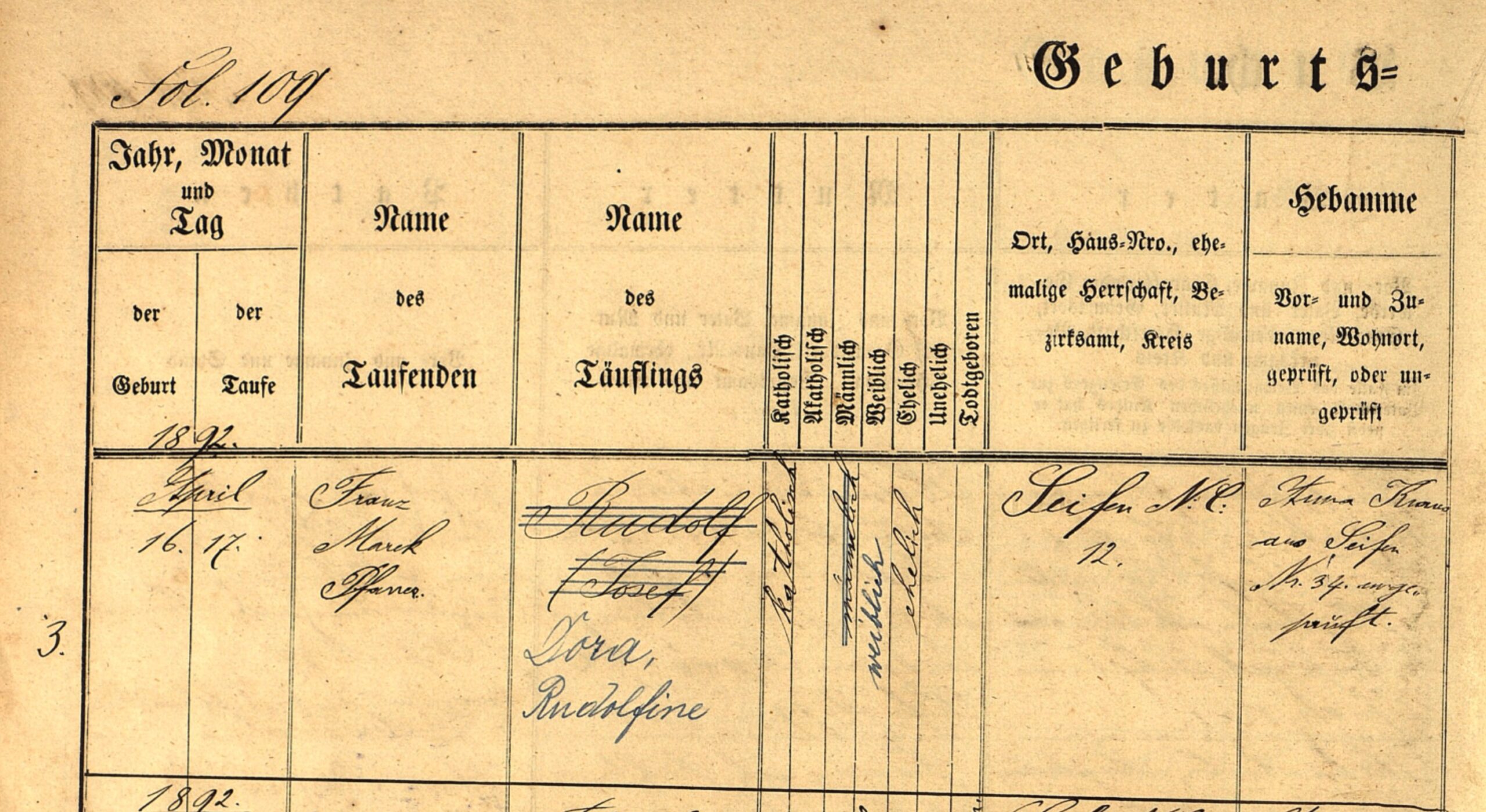
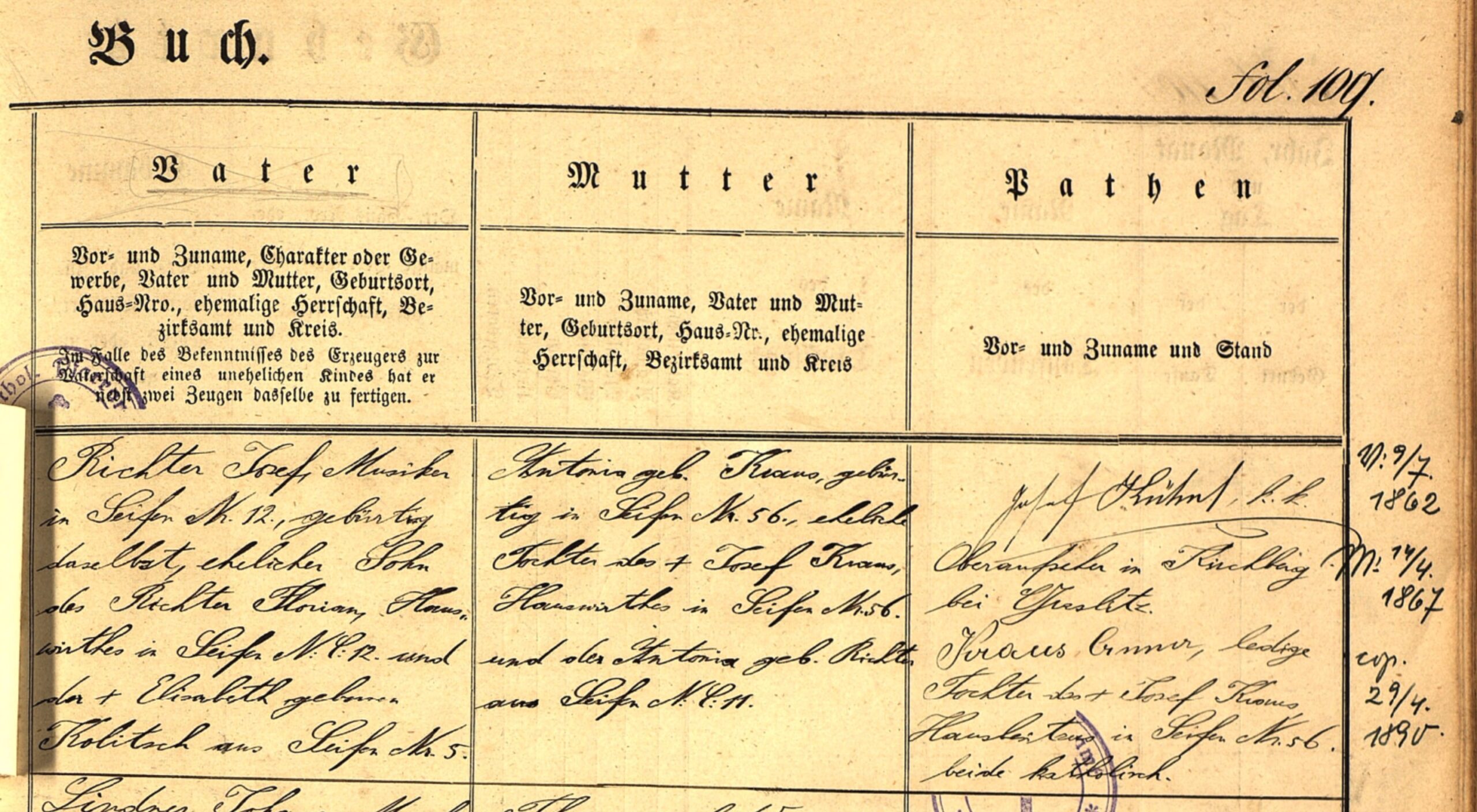
First, the original baptismal entry on page 109 (in analogous translation):
- On April 16, 1892, "Rudolf (Josef)" was born in Seifen No. 12, and on April 17 he was baptized Catholic in the church there.
- Anna Kraus is named as an "not certified" midwife, she lives in Seifen no. 34.
- The father is Josef Richter, musician in Seifen No. 12, born in Seifen, legitimate son of Florian Richter, landlord in Seifen No. 12 and Elisabeth, née Kolitsch, from Seifen No. 5, who died in 1892.
- The mother is Antonia, née Kraus, born in Seifen No. 56, legitimate daughter of Josef Kraus, landlord in Seifen No. 56, who died in 1892, and Antonia, née Richter, from Seifen No. 11.
- The godparents are Josef Kühne(?), k. k. Oberaufseher in Kirchlig(?) near Geslitz (Graslitz ?) and Anna Kraus, unmarried daughter of Josef Kraus, landlord in Seifen No. 45, who died in 1892, both Catholic.
- In addition, there is a marginal note about the birth and the marriage of the parents, with a different handwriting. Mentioning this data directly here is rather unusual, perhaps this happened when the note on the name change was added. Due to that, the father was born on July 9, 1862, the mother on April 14, 1867, and the marriage took place on April 29, 1890.
Rudolf is the second child of the parents, about 2 years after the wedding, the mother was 25 years old at birth, the father 29. The mother’s sister was apparently a midwife and godmother at the same time.
All participants (except for one godfather) lived close to each other and were already born in Seifen.
Change of name in the baptismal register
Now, the pasted-in note, stamped by the Catholic parish office of Seifen, is exciting.
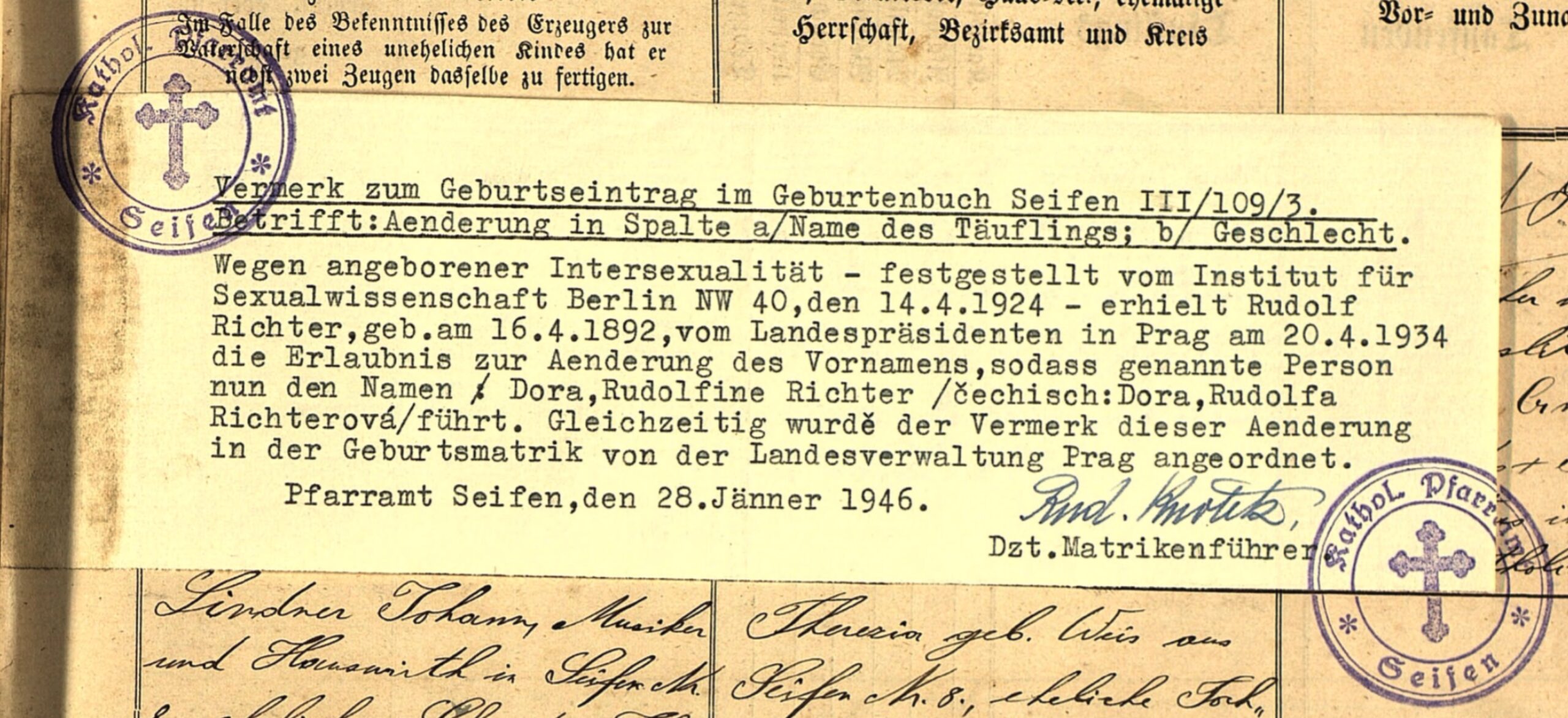
After that, on January 28, 1946, the baptismal register was corrected, here is the text (translated to English):
Note on the birth entry in the birth book Seifen III/109/3
Subject: Change in column a/name of the person being baptized; b/gender.
Due to congenital intersexuality – determined by the Institute for Sexology Berlin NW 40, 14.4.1924 – Rudolf Richter, born on 16.4.1892, received permission from the President of the State in Prague to change his first name, so that the named person now bears the name / Dora, Rudolfine Richter / Czech: Dora, Rudolfa Richterová /. At the same time, the registration of this change in the birth register was ordered by the Prague Provincial Administration.
Pastoral office Seifen, 28 January 1946
In addition, the baptismal entry was corrected, the name "Rudolf (Josef)" was crossed out, instead "Dora Rudolfine" was added. In addition, the entry in the gender column has been changed from "male" to "female".
The entry raises several questions:
- The name change was approved in 1934, why was it not registered until 1946? In January 1946, the official deportation of the Germans from Czechoslovakia began at the same time, almost exactly when the note was written. It is possible that this happened later in such a remote place as Seifen. In any case, the text is still written in German, by the presumably German-speaking pastor.
- In 1934, Dora received permission to change her name from Prague (capital of Czechoslovakia), not from Germany. This may be for the simple reason that she was born on Czech territory and therefore had to turn to Prague, and not to Berlin.
- The reason given for the name change is "intersexuality", although Dora was clearly trans. The expert opinion(?) was prepared in 1924 at the Berlin Institute for Sexology, which fits quite well with the dissertation of Werner Holz, who has dealt with her in detail. It is not possible to determine at the moment whether intersex was deliberately used to enable the name change (name changes for intersex persons were not an uncommon procedure), whether the district president(?) did not make a conscious distinction between intersex and trans*, or whether there are other reasons.
- Although the instruction refers only to the change of name, the priest has corrected the gender entry in addition to the name.
Permit from Prague
At the end of the baptismal register, where various loose letters and documents are gathered, there is also a letter about the name change. Presumably, this letter was sent to the rectory, and the baptismal entry was subsequently corrected.

The text is available in Czech, here first of all an analogous translation into English based on machine translation. A "correct" translation will follow.
- The letter is dated April 23, 1934 from Prague.
- At that time, Dora was apparently still living in Berlin, at Motzstraße 76, and was working as a flower seller.
- On 26 February, an application(?) for a name change had arrived in Prague, which was approved on 20 April of the same year.
- Instead of the previous name "Rudolf Richter", Dora can now officially call herself "Dora Rudolfa Richterová" (only the Czech name is listed).
- The letter asks the parish office to correct the baptismal entry.
- The copy is from January 1946, i.e. shortly after the end of the war, perhaps it was only then that it was sent to the pastoral office.
Dora’s family
In addition to the entry on Dora herself, it is interesting to see what else can be found in the Seifen church records for Dora’s family (Link):
- The ancestors:
- Her father was Josef Richter, born 9 July 1862, † 22 September 1931, son of Florian Richter and Elisabeth née Kolitsch.
- Florian Richter, on the other hand, is the son of Johann Richter and Josefa Lenhart.
- And Elisabeth Richter née Kolitsch is the daughter of Ignaz Kolitsch and Elisabeth Brennig.
- Her mother was Antonia née Kraus, born 14 April 1867, † 15 December 1938, daughter of Josef Kraus and Antonia née Richter.
- Josef Kraus, on the other hand, is the son of Herbert Kraus and Anna Günther.
- Antonia Kraus née Richter is the daughter of Franz Richter and Hedwig Wöllner.
- The parents married on April 29, 1890.
- Her father was Josef Richter, born 9 July 1862, † 22 September 1931, son of Florian Richter and Elisabeth née Kolitsch.
- The siblings:
- Dora was the second eldest child, there were 7 siblings (the statements differ slightly from the information given in wood)
- Josef Florian was born on August 16, 1890, later married to Julia Sandig. In 1920 the couple had a son Rudolf Josef, who was only 11 years old, and in 1926 a second son Gerhard, who was only one year old.
- On August 29, 1894, Francisca Rosa was born, later married to Albert Kraus. The couple had a son in 1931, but he was only a few weeks old.
- Florian was born on December 13, 1896.
- Hermann Emil was born on June 3, 1899.
- On September 2, 1901, Ida Stefanie was born, who in 1923 gave birth to an illegitimate child who was only a few weeks old.
- In July 1905 twins were born, on July 15 Anna, who died again in September, and on July 17 Albert, who lived only one week (different dates of birth according to the church register).
Holz’s statement about the kinship marriage that Dora’s parents were cousin and base could not yet be confirmed, perhaps there is a connection in an earlier generation.
Assignment of siblings Holz vs. church book
If you compare the data found with the data for Holz, there are some deviations. Some of the information looks as if it had been collected a few years earlier and not in 1924. But altogether, the assignment seems plausible.
| Person acc. Holz | Birth acc. Holz | presumed person acc. church book | Children acc. church book | Notes |
|---|---|---|---|---|
| Brother, 30 years old, healthy, married, 2 healthy children | c. 1894 | Josef Florian * 1890, ⚭ Julia Sandig | Rudolf Josef (illegitimate) 1920–1931, Gerhard 1926–1927 | 4 years deviation, a child not yet found, marriage ceremony not yet found |
| Brother, 26 years old, healthy, married, 1 healthy child | c. 1898 | Florian, * 1896 | 2 years deviation, marriage ceremony and child not yet found | |
| Brother, 20 years old, healthy, unmarried | c. 1904 | Hermann Emil * 1899 | 5 years deviation | |
| Sister, 29 years old, healthy, unmarried, had 1 child who died after 6 weeks | c. 1895 | Francisca Rosa * 1894, ⚭ 1922 Albert Kraus Rudolf, 1931–1931 | Wedding ceremony is missing at Holz, must have had a child before marriage | |
| Sister, 24 years old, healthy, unmarried, had 1 child who died after 3 weeks | c. 1900 | Ida Stefanie, * 1901 | Anna Ida, 1923–1923 | |
| not mentioned | Anna and Albert, 1905–1905 |
Conclusion
With the data available here, the exact date of birth and, above all, the place of birth of Dora Richter are now known, we also have an address from 1934 and an official name change from the same year.
From here, further research can begin.
Dora’s whereabouts after 1933
Nothing is known about the further whereabouts of Dora Richter. As things stand today, we have a last trace with the name change of 1934, for which there are still no sources. There is only a statement by Charlotte Charlaque that Dora went to Karlovy Vary and opened a restaurant there (Wolfert 2021, p. 76).
In the church registers and registry registers for Seifen und Umgebung as well as Karlsbad, which can be searched online until about 1945, no entry for Dora’s death has yet appeared. We do not yet know whether she remained in the Karlovy Vary region, perhaps left the region after the invasion of Czechoslovakia by German troops, and whether she survived the Nazi era.
The whereabouts of her family – if they still had contact with her – are also unknown. Dora’s father died in 1931, her mother in 1938, for the siblings (see above) and their descendants would have to be researched.
Dora’s hometown of Seifen, Czech Ryžovna, was mostly German populated until the 2nd World War, but after the war the place lost almost the entire population. In the meantime there are only a few houses left, since 1970 there are no more registered inhabitants (Wikipedia).
Further research possible
Based on the newly found sources, further research is now possible:
- There is approval for the name change of 1934 in Prague. There is probably a file on this, which may even contain the expert opinion of 1924.
- The address for 1934 is Motzstraße 76 in Berlin, but there is no entry for her at this address in the Berlin directories of the time.
- There are data of the siblings that can be used to research the whereabouts of the family, it is possible that Dora later went with someone from the family (just as Lili Elbe kept in touch with siblings).
Acknowledgments
Many thanks to Ralf Dose, Rainer Herrn and Raimund Wolfert for valuable hints for the research and for sources!
Sources
- Abraham, Felix. “Genitalumwandlung an Zwei Männlichen Transvestiten.” Zeitschrift Für Sexualwissenschaft, no. 18 (1931): 223–26.
- Curtius, Carlotta, Baronin von [pseud. of Charlotte Charlaque]. “Reflections on the Christine Jorgenson Case.” ONE, no. March (1955): 27–28.
- Herrn, Rainer. Der Liebe und dem Leid. Das Institut für Sexualwissenschaft 1919-1933. Berlin: Suhrkamp, 2022.
- Holz, Werner. “Kasuistischer Beitrag zum sogenannten Transvestitismus (erotischen Verkleidungstrieb) mit besonderer Berücksichtigung der Aetiologie dieser Erscheinung.” Dissertation, Friedrich-Wilhelm-Universität, 1924.
- Meyerowitz, Joanne. How Sex Changed. A History of Transsexuality in the United States. Cambridge, Mass.: Harvard University Press, 2004.
- Najac, Pierre. “L’Institut de la Science Sexuelle à Berlin.” In Vénus et Mercure., by Janine Merlet, 165–92. Paris: Editions de la Vie Moderne, 1931.
- “Operative Umwandlung von Männern in Frauen gelungen. Die Erfahrungen aus drei Berliner Fällen.” Die Geburtenregelung, no. 4 (1933): 83.
- Wolfert, Raimund. Charlotte Charlaque. Transfrau, Laienschauspielerin, »Königin der Brooklyn Heights Promenade«. Berlin: Hentrich & Hentrich, 2021.
Links
- Toni Ebel exhibition: https://toni-ebel.de/
- Wikipedia entry on Dora Richter: https://en.wikipedia.org/wiki/Dora_Richter
- Wikipedia entry on Seifen/Ryžovna: https://de.wikipedia.org/wiki/Ry%C5%BEovna
- Archivprojekt Porta fontium: https://www.portafontium.eu/
- Catholic church records Seifen/Ryžovna https://www.portafontium.eu/contents/register/soap-pn/cirkev-rimskokatolicka/ryzovna
- Baptismal record Dora Richter: https://www.portafontium.eu/iipimage/30068027/ryzovna-05_1120-nx and https://www.portafontium.eu/iipimage/30068027/ryzovna-05_1130-xn
- Letter from Prague regarding the name change: https://www.portafontium.eu/iipimage/30068027/ryzovna-05_2660-x


